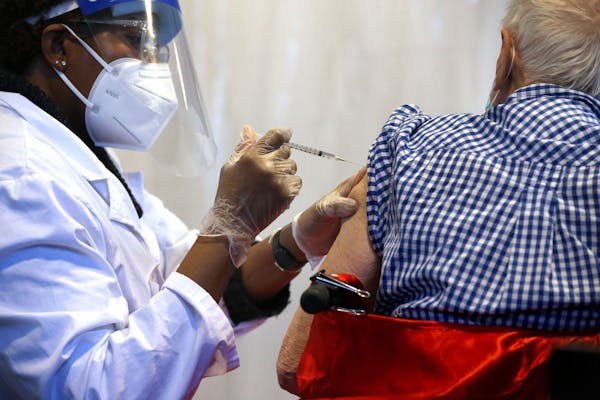Minnesota's latest COVID-19 data show more evidence of a peak in the state's spring wave, and that vaccines helped blunt its severity even if they were less protective than earlier in the pandemic.
The state on Tuesday reported another 2,188 infections, but the seven-day average of new infections peaked on May 11 and has declined steadily. The 419 COVID-19 hospitalizations in Minnesota on Friday were an increase from earlier in the week but still lower than the recent high of 441 on May 19 — with only 8% of patients needing intensive care. As many as 30% of COVID-19 hospitalizations involved intensive care during peaks last year.
The daily number is a significant undercount — excluding the results of at-home testing — but it is clear that immunity as a result of vaccinations and recent infections has reduced the number of COVID-19 cases that produce severe illness, said Michael Osterholm, director of the University of Minnesota's Center for Infectious Disease Research and Policy.
Many people thought the pandemic was over at this time last year, though, Osterholm said, which should be a cautionary tale as immunity levels wane in the coming months and new variants emerge of the coronavirus that causes COVID-19.
"Look what happened — delta showed up a month from now, relative to a year ago, and then omicron," Osterholm said. "In a way, we're still in that kind of world. We don't know yet what the next variant or variants will be."
COVID-19 infection rates appear to be declining in parts of the northeastern U.S. as well, but are rising in some southern states such as Virginia, according to the Centers for Disease Control and Prevention. However, Osterholm said it's not a simple matter of seasonality in which people in warmer climates are moving indoors and increasing their risks for viral exposure. States such as Alabama and Mississippi have some of the lowest COVID-19 case rates in the nation right now.
"It doesn't make sense," he said. "Why is India picking up all of a sudden and yet we see parts of the world [similar to] India where almost nothing is happening?"
COVID-19 hospitalizations don't break as sharply between the vaccinated and the unvaccinated as they did last year, but Minnesota's latest breakthrough data on Monday showed the shots still offered protection.
The age-adjusted rate of COVID-19 hospitalizations was 24.5 per 100,000 unvaccinated Minnesota adults in the second week of May, compared to 16.6 among fully vaccinated adults and 6.9 among vaccinated adults who had received booster shots when eligible to maintain immunity levels.
Minnesota is among the first states to report COVID-19 outcomes by whether people have been vaccinated and also by people who have received boosters. Among comparable states, Colorado and Utah showed little difference in infection rates by vaccine status but people who had received boosters were less likely to be hospitalized than fully vaccinated and unvaccinated people.
Wisconsin's new breakthrough data revealed an oddity: hospitalization rates were higher in April among boosted residents than among people who had received only the initial course of COVID-19 vaccine.
Demographic and social differences in the two vaccinated populations likely explain the data, which is why weekly breakthrough numbers are no substitute for vaccine effectiveness research that compares randomized study groups, said Dr. Ryan Westergaard, chief medical officer for the Wisconsin Department of Health Services.
"People who go get boosters also might be more likely to get tested if they develop symptoms," he said. "People who get a booster might change their behavior so they are exposed more" to the virus.
"As the virus has evolved, it is true that the effectiveness of vaccine at preventing any infection, even mild infection, that percent effectiveness has gone down," he added. "But the effectiveness for preventing death and severe disease has remained high, and this has been seen in studies all over the world."
The protection shows in the Minnesota data when comparing rates of COVID-19 outcomes rather than whole numbers.
The state has identified 24 COVID-19 deaths of seniors so far in May by their vaccination status — with 11 being among the boosted, 9 among the fully vaccinated, and only 4 among the unvaccinated.
However, the risk is much higher among unvaccinated seniors when considering that there are only 59,000 of them in Minnesota, compared with 703,000 seniors who have received boosters.
Four of five COVID-19 deaths reported by the Minnesota Department of Health on Tuesday involved seniors, as well as residents of long-term care facilities.
The proportion of COVID-19 deaths involving seniors has increased this spring as it has decreased among younger adults. Seniors made up 72% of the 3,939 COVID-19 deaths Minnesota has reported since Nov. 1, but 83% of the 223 deaths reported since April 1.

Minneapolis schools, teachers reach tentative agreement to avert strike
Men knock woman down and steal her dog during walk, St. Paul police say

Minneapolis reaches $150k settlement with eyewitness of George Floyd's murder
He grew up legally in Minnesota, but immigration law gap may one day force student to leave

